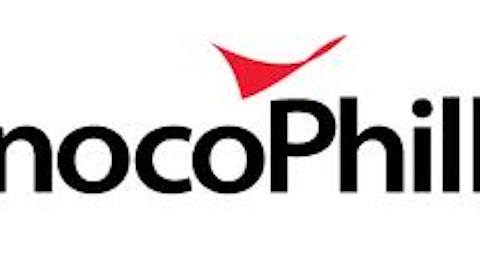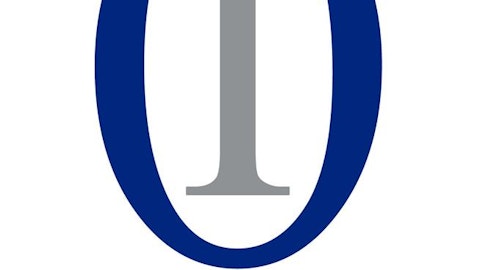
Phillips 66 became the downstream company, focusing on refining and marketing, while ConocoPhillips (NYSE:COP) (who kept its name in the amicable breakup) focuses on exploration and production.
After one year, Phillips 66 (NYSE:PSX), one of the largest U.S. independent refiners, has reported first-quarter earnings, and things are looking good.
“We achieved strong financial results in the first quarter by capturing favorable chemicals and refining margins,” said Chairman and Chief Executive Greg Garland.
The company’s refining segment adjusted earnings doubled to $909 million, while the chemicals segment’s adjusted earnings improved 30% to $282 million. Overall, the company reported a net profit of $1.41 billion, or $2.23 a share, up from $636 million, or $1 a share, a year earlier.
Phillips 66 (NYSE:PSX) owns 11 domestic refineries with a combined capacity of 1.8 million barrels a day, and it has four refineries outside the U.S. The company also owns 7,000 commercial gas stations across the country.
Along with other refining companies, Phillips 66 (NYSE:PSX) took advantage of the natural gas and hydraulic fracturing boom, and increased its capacity to transport crude from the shale formations to the refineries. In the first quarter of 2013, the company nearly doubled the number of barrels per day of crude it processed from last year.
Investors like spin-off companies such as Phillips 66 (NYSE:PSX) because it is easier to understand and predict what will happen with a narrower set of parameters to analyze. A company that is too big, broad, and diversified can make it hard to truly grasp a big picture. More focused companies attract investors who appreciate the narrow, more detailed focus, with a financial history. Phillips 66 reflects that, with its stock up 86% in the past year.
ConocoPhillips (NYSE:COP) has not done quite as well since the breakup. The company’s first-quarter earnings fell 27%, from $2.94 billion to $2.14 billion (or $1.73 a share) reflecting in part the year-earlier spin off of its refining business and $950 million in asset sale gains. Average daily production of oil and gas fell 1.6% after recent asset sales and the company has said that output likely would fall further this quarter.
The main reasons for earnings decline were higher depreciation, amortization, and depletion expenses and lower prices. Production was flat at 1,596 million barrels of oil equivalents per day (BOE/d). The company expects production levels to be lower next quarter.
ConocoPhillips (NYSE:COP) isn’t the only newly single company to split ways with downstream operations. Marathon Oil Corporation (NYSE:MRO) shed some weight and spun off Marathon Petroleum Corp (NYSE:MPC).
Marathon Petroleum was spun off from Marathon Oil Corporation (NYSE:MRO) in June, 2011. Marathon Petroleum Corp (NYSE:MPC) now owns and operates the crude oil pipeline and refining operations, or the “downstream operations.”
Marathon Petroleum reported a profit of $725 million in the first quarter, up 22% from $596 million the same period last year.
Like Phillips 66 (NYSE:PSX), Marathon Petroleum Corp (NYSE:MPC) has benefited from the current supply of cheap domestic crude oil and natural gas, and hydraulic fracturing. The refining-and-marketing segment’s operating profit increased 17% to $1.11 billion.
Marathon Oil Corporation (NYSE:MRO)’s first-quarter profit fell 8% compared to the same period in 2012 to $383 million due to lower oil prices — the same reason ConocoPhillips (NYSE:COP) cited. Revenue grew 1.6% to $4.1 billion.
Marathon Oil reported a 15% production increase (available for sale) of 471,000 BOE/d from all segments, up from 409,000 BOE/d in the first quarter of 2012.
Both sets of companies reflect similar situations and numbers. Both Phillips 66 and Marathon Petroleum, the “downstream” companies, saw significant increases. Both ConocoPhillips (NYSE:COP) and Marathon Oil, the production and exploration companies, or “upstream,” experienced less income due to lowered oil prices. The success and increased activity of the downstream companies has contributed significantly to the lowered oil prices, and the downstream companies are benefiting from it.
If the respective companies had not all parted ways, all overall earnings would have been nearly flat or unimpressive. The $900 million profit at Phillips 66 would have made up for the $800 million decrease at ConocoPhillips (NYSE:COP). The Marathon Petroleum improvement of $129 million would have made up impressively for the $50 million decrease at Marathon Oil, but few people would have been impressed by a less than 12% net increase when most refining companies are reporting stellar income (like Chesapeake Energy). However, these side-by-side comparisons help shed a new light on why ExxonMobil’s numbers were so incredibly flat.
ConocoPhillips and Phillips 66 (NYSE:PSX), just like Marathon Oil and Marathon Petroleum before them, did the right thing by going their separate ways. The stand-alone companies give themselves, and investors, a better chance to succeed, without the weight of the other company pulling them down. The exploration and production side of the business has plenty of potential to rebound and make a comeback in the near future as the potential and abundance of shale gas and liquified natural gas continue to change the playing field.
All four companies continue to be a great long-term investment, each on their own, individual merits.
The article Phillips 66 and ConocoPhillips a Year Later originally appeared on Fool.com and is written by Erin McBride.
Copyright © 1995 – 2013 The Motley Fool, LLC. All rights reserved. The Motley Fool has a disclosure policy.


